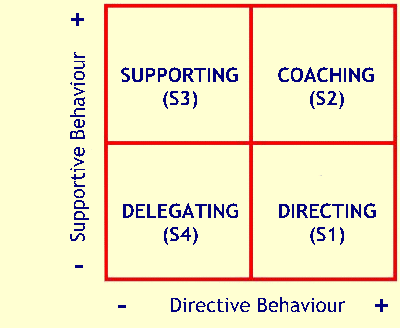
Situational Leadership
This is a term that can be applied generically to a style of leadership, but that also refers to a recognised, and useful, leadership model. In simple terms, a situational leader is one who can adopt different leadership styles depending on the situation. Most of us do this anyway in our dealings with other people: we try not to get angry with a nervous colleague on their first day, we chase up tasks with some people more than others because we know they'll forget otherwise.
But Ken Blanchard, the management guru best known for the "One Minute Manager" series, and Paul Hersey created a model for Situational Leadership in the late 1960's that allows you to analyse the needs of the situation you're dealing with, and then adopt the most appropriate leadership style. It's proved popular with managers over the years because it passes the two basic tests of such models: it's simple to understand, and it works in most environments for most people. The model doesn't just apply to people in leadership or management positions: we all lead others at work and at home.
LEADERSHIP BEHAVIOUR
Blanchard and Hersey characterised leadership style in terms of the amount of direction and of support that the leader gives to his or her followers, and so created a simple grid:

Directing Leaders define the roles and tasks of the 'follower', and supervise them closely. Decisions are made by the leader and announced, so communication is largely one-way.
Coaching Leaders still define roles and tasks, but seeks ideas and suggestions from the follower. Decisions remain the leader's prerogative, but communication is much more two-way.
Supporting Leaders pass day-to-day decisions, such as task allocation and processes, to the follower. The leader facilitates and takes part in decisions, but control is with the follower.
Delegating Leaders are still involved in decisions and problem-solving, but control is with the follower. The follower decides when and how the leader will be involved.
Effective leaders are versatile in being able to move around the grid according to the situation, so there is no one right style. However, we tend to have a preferred style, and in applying Situational Leadership you need to know which one that is for you.
DEVELOPMENT LEVEL
Clearly the right leadership style will depend very much on the person being led - the follower - and Blanchard and Hersey extended their model to include the Development Level of the follower. They said that the leader's style should be driven by the Competence and Commitment of the follower, and came up with four levels:
| D4 | High Competence High Commitment |
Experienced at the job, and comfortable with their own ability to do it well. May even be more skilled than the leader. |
| D3 | High Competence Variable Commitment |
Experienced and capable, but may lack the confidence to go it alone, or the motivation to do it well / quickly |
| D2 | Some Competence Low Commitment |
May have some relevant skills, but won't be able to do the job without help. The task or the situation may be new to them. |
| D1 | Low Competence Low Commitment |
Generally lacking the specific skills required for the job in hand, and lacks any confidence and / or motivation to tackle it. |
Development Levels are also situational. I might be generally skilled, confident and motivated in my job, but would still drop into Level D1 when faced, say, with a task requiring skills I don't possess. For example, lots of managers are D4 when dealing with the day-to-day running of their department, but move to D1 or D2 when dealing with a sensitive employee issue.
SITUATIONAL LEADERSHIP
You can see where this is going. Blanchard and Hersey said that the Leadership Style (S1 - S4) of the leader must correspond to the Development level (D1 - D4) of the follower - and it's the leader who adapts.
For example, a new person joins your team and you're asked to help them through the first few days. You sit them in front of a PC, show them a pile of invoices that need to be processed today, and push off to a meeting. They're at level D1, and you've adopted S4. Everyone loses because the new person feels helpless and demotivated, and you don't get the invoices processed.
On the other hand, you're handing over to an experienced colleague before you leave for a holiday. You've listed all the tasks that need to be done, and a set of instructions on how to carry out each one. They're at level D4, and you've adopted S1. The work will probably get done, but not the way you expected, and your colleague despises you for treating him like an idiot.
But swap the situations and things get better. Leave detailed instructions and a checklist for the new person, and they'll thank you for it. Give your colleague a quick chat and a few notes before you go on holiday, and everything will be fine.
By adopting the right style to suit the follower's development level, work gets done, relationships are built up, and most importantly, the follower's development level will rise to D4, to everyone's benefit.
To make Situational Leadership work, you need to go through a training programme, where you'll learn about how to operate effectively in all the Leadership Styles, and how to determine the Development Level of others. And the Blanchard organisation would be happy to tell all about their training programmes worldwide.
You can also get the basics from Ken Blanchard's "Leadership and the One Minute Manager."
© Chimaera Consulting Limited 1999.